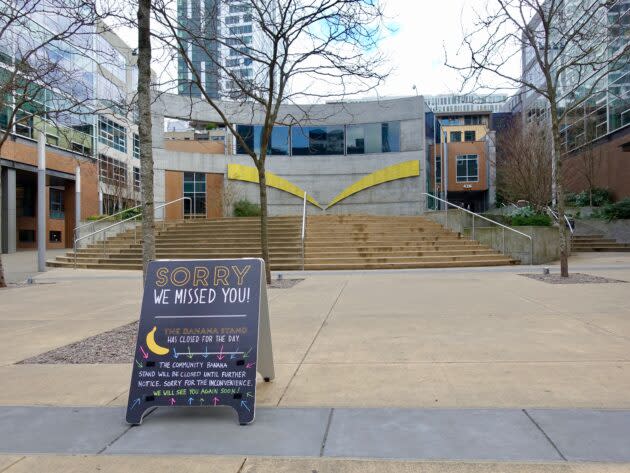It’s true! King County says social distancing is slowing down the coronavirus outbreak

Citing fresh statistics, public health officials today confirmed that social distancing measures “appear to be making a difference in slowing the spread of COVID-19” in Seattle and King County.
But in a blog post, they said it’s way too early to put up the “Mission Accomplished” sign. Social distancing measures will likely be required for weeks longer.
The good news and the continuing caveat are based on two new reports from the Bellevue, Wash.-based Institute for Disease Modeling. In one study, the institute worked with state and county public health officials as well as Facebook to analyze anonymized mobility data. Facebook’s data came from its Disease Prevention Maps.
That analysis showed reductions in mobility beginning in early March — an observation that parallels other findings gleaned from navigation and mapping data.
Previously: Data mining underscores the importance of social distancing in China — and in Seattle
For the other study, the institute’s researchers ran computer simulations to see whether those reductions could be correlated with reductions in the coronavirus infection rate. The simulations, based on data about testing, diagnosis and deaths from King County’s records, suggested a decline in the virus’ spread.
The key metric is known as the effective reproductive number, or Re. Based on how the simulations fit the data, the number dropped from about 2.7 in late February to 1.4 on March 18, the institute reported.
Re describes the number of new transmissions stemming from each infection. If the simulations are correct, each person with COVID-19 passed on the infection to 2.7 people on average a month ago, but only half as many people as of last week.
To sustain a drop in new cases, the number has to fall below 1.
“We are seeing a positive effect from the social distancing and other measures we’ve put in place, although significant numbers of cases and deaths continue to occur,” Jeff Duchin, health officer for Public Health – Seattle & King County, said in today’s posting. “It’s important to note that these findings are based on relatively few cases and persons tested, and therefore come with a great deal of uncertainty. Continued monitoring with the measures in place will lead to more reliable data.”
Duchin said the latest results shouldn’t be seen as providing an opening for relaxing restrictions on mobility.
“The threat of a rebound that could overwhelm the health care system remains and will remain for the foreseeable future if we let up too soon,” he said. “We absolutely need to continue the current distancing measures and to continue monitoring the epidemic and its impacts as testing increases to determine if any adjustment to our response is needed.”
Coronavirus Live Updates: The latest COVID-19 developments in Seattle and the world of tech
In the meantime, Duchin said “we must continue to advocate for and provide support to the many Washingtonians who are suffering from unintended economic and social impacts of this necessary disease control strategy.”
During a teleconference with reporters, Duchin said he and other public health officials will be looking for several developments that could prompt a loosening of the stay-at-home orders.
Those developments include the widespread availability of test kits that can rapidly identify people who have the virus, procedures for quickly tracing those who have been in contact with infected people, more hospital capacity for treating COVID-19 patients, and proven treatments for the disease.
“I don’t see that in the next month,” Duchin said.
Daniel Klein, computational research team lead at the Institute for Disease Modeling, agreed with that prognosis. He said his team’s next research paper will address how to keep COVID-19 from rebounding once mobility restrictions are limited.
“We don’t have all the answers yet,” he said, “but we know that it’s going to require a lot more testing than we’re able to do today. And we know that it’s possible by looking at other places around the world — for example, South Korea and China — that have been able to limit the spread of COVID using these kinds of techniques.”
Update for 1:20 p.m. PT March 30: We’ve added comments from today’s teleconference.

 Yahoo News
Yahoo News 